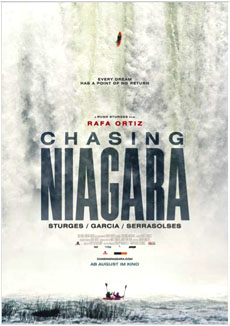
Austria | USA | Canada | Mexico 2015
Opening August 25, 2016
Directed by: Rush Sturges
Writing credits: Mark Anders
Principal actors: Rafa Ortiz, Rush Sturges, Evan Garcia, Gerd Serrasolses, Aniol Serrasolses Rafa Ortiz learned the sport of kayaking as a young boy. He meets others with a similar history: Rush Sturges and Evan Garcia from northwestern USA and brothers Gerd and Aniol Serrasolses from Spain. Although kayaking is an individual sport, here, the five of them paddle together as a team, a good idea considering the dangers involved. Sturges was long-recognized as a top professional kayaker. Now he has the opportunity to prove his talent as a director and film maker. He films Ortiz over a period of three years as Ortiz trains to achieve his goal: kayaking down the Niagara Falls on the border between northeastern US and Canada. This entails much practice on similarly dangerous rivers and falls such as: Rio Aqua Azul in Mexico, the Palouse Falls in Washington and the Sahalie Falls in Oregon, both USA.
Rafa Ortiz learned the sport of kayaking as a young boy. He meets others with a similar history: Rush Sturges and Evan Garcia from northwestern USA and brothers Gerd and Aniol Serrasolses from Spain. Although kayaking is an individual sport, here, the five of them paddle together as a team, a good idea considering the dangers involved. Sturges was long-recognized as a top professional kayaker. Now he has the opportunity to prove his talent as a director and film maker. He films Ortiz over a period of three years as Ortiz trains to achieve his goal: kayaking down the Niagara Falls on the border between northeastern US and Canada. This entails much practice on similarly dangerous rivers and falls such as: Rio Aqua Azul in Mexico, the Palouse Falls in Washington and the Sahalie Falls in Oregon, both USA.
While enjoying these spectacular scenes, we also get some of the history of the Niagara Falls. In 1901 the first person went over the falls in a barrel and survived. Most interesting is that it was a woman, Annie Edson Taylor, and she was already 63 years old. Since then 15 people have sailed over the Falls by different methods; ten survived and five died in the attempt. There are 12 million tourists each year; the Niagara Falls is known as the “honeymoon capitol of the world.” We get an idea of this history and the atmosphere through old black and white film sequences. Today it is illegal to go down the Falls both as a safety measure and because it is an official border between two countries.
The film will be especially interesting to those who are interested or even active in the sport of kayaking, which has its special rules. For example it is not unusual to throw away the paddle once one is in the clutches of the churning water and can no longer control movement. For others the fantastically beautiful scenery filmed on location in the USA, Mexico and Brazil, will attract viewers. Much is up close as there seems to be cameras mounted on the athletes’ helmets. Perhaps it becomes a big redundant after a while, as white water begins to look the same everywhere. I would like to know how three years of having fun and filming could be financed, considering that, in the end, this entailed a production team of 15 people. ()
